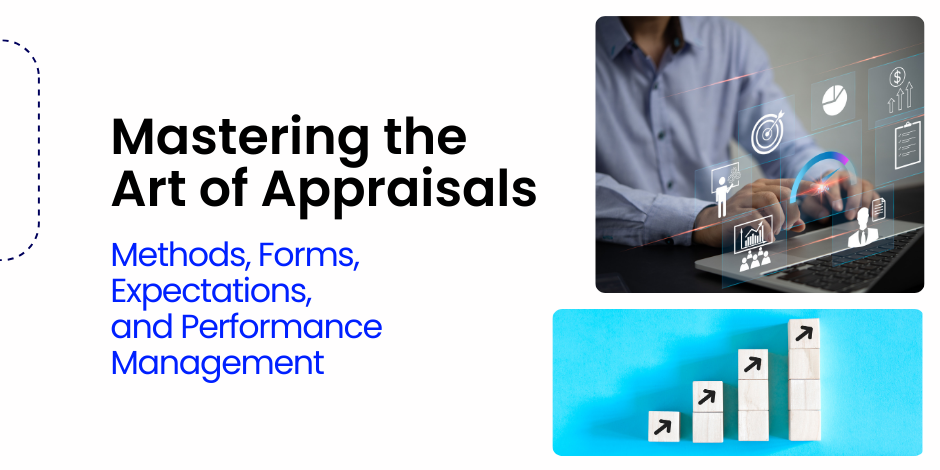Performance Management: Mastering the Art of Appraisals – Methods, Forms, Expectations, and More

Stay Informed With Our Weekly Newsletter
Receive crucial updates on the ever-evolving landscape of technology and innovation.
In today’s competitive business environment, organizations must manage their human resources effectively.
One aspect of this management is the art of appraisals, which is vital in performance management and facilitating growth and development.
What are performance appraisals?

Performance appraisals, also known as performance reviews or evaluations, are systematic processes that assess an employee’s job performance and provide feedback regarding their strengths, weaknesses, and areas for improvement.
These assessments typically occur annually or semi-annually and involve evaluating an employee’s performance against predetermined goals and standards.
Performance appraisals serve multiple purposes within an organization:
- They provide a formal platform for managers to communicate expectations, recognize achievements, and address performance-related issues.
- They assist in identifying training and development needs, allowing organizations to tailor their learning programs to enhance employee skills and competencies.
- Performance appraisals help make decisions regarding promotions, salary adjustments, and career progression.
The significance of effective appraisals in performance management
Effective performance management drives employee engagement, motivation, and overall job satisfaction.
When done well, they strengthen the employer-employee relationship by fostering open communication and feedback exchange.
By providing employees with a clear understanding of their performance expectations, appraisals shape and align their behavior with organizational goals.
Furthermore, effective appraisals contribute to a fair and transparent performance assessment process.
Consistent and objective evaluations minimize biases and discrimination, ensuring equal opportunities for growth and recognition within the organization.
Ultimately, effective performance management promotes a culture of continuous improvement and helps organizations achieve their strategic objectives.
Performance management appraisal methods
Organizations employ various methods to assess employee performance during performance appraisals.
Each method has advantages and limitations, and selecting the most appropriate method depends on factors such as the nature of the job role, organizational culture, and available resources.
Traditional methods
Traditional performance appraisal methods include graphic rating scales, ranking modes, and essay evaluations.
Graphic rating scales involve rating employees against predefined performance criteria, while ranking methods involve ranking employees based on their performance relative to their peers.
Essay evaluations require managers to provide detailed written assessments of an employee’s performance.
While traditional methods provide a structured framework for evaluation, they often lack sufficient objectivity and can be subject to rater biases.
Therefore, organizations are increasingly adopting more modern and inclusive methods to enhance the accuracy and fairness of performance management.
Utilising performance appraisal forms
Performance appraisal forms provide a standardized template for evaluating employee performance.
These forms typically consist of criteria or competencies against which employees are assessed.
Using appraisal forms ensures consistency and enables managers to capture relevant performance data systematically.
Appraisal forms should align with the organization’s performance management framework and be customized to suit specific job roles or departments.
By using appraisal forms, organizations can objectively compare employee performance across teams or divisions and identify areas for improvement at both individual and organizational levels.
Setting employee expectations

Before conducting a performance appraisal, it is essential to establish clear and realistic performance expectations for employees.
Setting expectations involves defining performance goals and objectives, outlining job responsibilities, and communicating performance standards.
When setting expectations, it is crucial to ensure they are specific, measurable, achievable, relevant, and time-bound, commonly known as SMART goals.
Clear expectations give employees a clear understanding of what is expected, enabling them to focus their efforts and work towards achieving organizational objectives.
Regular communication and feedback throughout the performance management cycle also contribute to aligning employee expectations with organizational goals.
Setting employee expectations
Dealing with poor performance is a challenging yet necessary aspect of performance appraisals.
Managers must address performance issues promptly and effectively to ensure employees receive the support and guidance needed for improvement.
When managing poor performance, it is essential to have open and honest conversations with employees.
Managers should provide constructive feedback, discuss improvement areas, and provide specific examples of performance gaps.
Offering support through training programs or mentoring can also help employees overcome performance challenges.
If poor performance persists despite intervention, managers may need to take appropriate disciplinary actions, such as implementing performance improvement plans or initiating a formal performance management process.
These measures ensure employees understand the consequences of continued poor performance and are given opportunities to rectify their deficiencies.
Best practices for successful appraisals in project management
Successful performance appraisals require careful planning, effective communication, and continuous improvement.
To maximize the benefits of performance appraisals, organizations should consider the following best practices:
- Train managers and employees on the performance appraisal process and expectations.
- Ensure clear and open communication throughout the performance appraisal cycle, encouraging employees to voice concerns and suggestions.
- Offer regular feedback and coaching to employees to foster their growth and development.
- Ensure performance appraisals are conducted objectively and consistently using standardized criteria and assessment methods.
- Recognize and reward employees for their contributions and achievements.
- Use performance appraisals to identify training and development needs and create individual development plans.
- Regularly review and update the performance appraisal process to accommodate changing business needs and industry trends.
- Provide managers with the tools and resources to effectively conduct performance appraisals, such as training materials, assessment templates, and guidelines.
Performance appraisal cycles

Performance appraisals typically occur on a cyclical basis.
The frequency of appraisals may vary depending on organizational preferences and industry practices.
Common appraisal cycles include annual, biannual, or quarterly reviews.
Annual appraisals are widely adopted and allow managers to evaluate an employee’s performance over a year.
Biannual and quarterly reviews offer more frequent feedback and help adjust performance expectations and goals in a rapidly changing business environment.
The timing of performance appraisals should consider factors such as budget cycles, business peaks and troughs, and employee availability.
Regularly scheduled appraisals ensure a consistent and structured approach to performance assessment while providing employees with timely feedback and growth opportunities.
Conclusion
Mastering the art of appraisals is critical for organizations looking to optimize employee performance and promote a culture of continuous improvement.
Performance appraisals provide a structured framework to assess employee performance, set expectations, and facilitate growth and development.
By implementing effective appraisal methods, utilizing standardized forms, and following best practices, organizations can maximize the benefits of performance appraisals and ultimately achieve their strategic objectives.
Ready to learn more? The Institute of Data programs will equip you with industry-relevant expertise and knowledge to succeed in today’s digital market.
We also offer free career consultations with our local team if you’d like to discuss your options.





